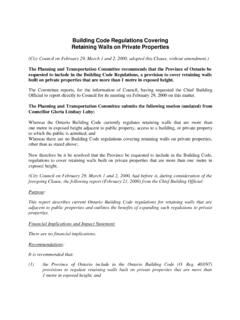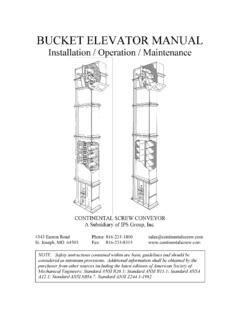Transcription of Revised January 20, 2022 COVID-19 Guidance for Taxi and …
1 Revised October 26, 2021 COVID-19 Guidance for taxi and Ride Share Vehicles The following recommendations for taxis, water taxis and ride share employers, drivers and vehicle owners are intended to reduce the spread of COVID-19 . This document describes the requirements operators must comply with under the Reopening Ontario Act. The aim and purpose of this document is to assist individuals and businesses with information related to the Ontario Government s reopening framework as well as Toronto Public Health requirements to reduce the spread of COVID-19 . It is important to know that breaches of some of these directions will constitute offences under provincial regulations or other public health legal requirements.
2 While we aim to provide relevant and timely information, no guarantee can be given as to the accuracy or completeness of any information provided. This Guidance is not intended to nor does it provide legal advice and should not be relied upon or treated as legal advice. Users seeking legal advice should consult with a qualified legal professional. Measures for All Workplaces, Organizations & Businesses Review the Guidance for Employers on Preventing COVID-19 in the Workplace to plan and implement protocols to keep staff and patrons safe. Operators must also consider the following: Staff attendance and operations o Employers must ensure staff complete a COVID-19 screening questionnaire before each work shift.
3 Hand hygiene and respiratory etiquette o Drivers and passengers should wash hands with soap and water or use hand sanitizer (70 90% alcohol concentration) provided hands are not visibly soiled. Remind staff to avoid touching their face, nose and mouth with unwashed hands. o Use hand sanitizer after handling money or helping with a passenger's personal items. o Post signs for cough and sneeze etiquette and hand sanitizing in vehicles where the information can be seen by passengers ( in a clear plastic sleeve). Cleaning and disinfection o In addition to routine cleaning, surfaces that have frequent contact with hands should be cleaned and disinfected at the following times: at least once per day when visibly dirty after transporting medical patients ( to and from hospital and other health care settings) after transporting passengers who display respiratory symptoms ( coughing, sneezing).
4 Revised October 26, 2021 o Employers/vehicle owners should provide all drivers with the appropriate cleaning products/disinfectant wipes for their vehicles. o See Cleaning and Disinfection for Public Settings for more information. Ontario has general information on COVID-19 and workplace health and safety where employers can learn about their responsibilities and how to protect workers at work. Workers can also get information about health and safety protections at the workplace. Transporting Passengers Safely Promote prevention measures to passengers on reducing risk to drivers and themselves on your website and through outgoing telephone messages.
5 Posters can be posted in the vehicle. Install barriers: Consider installing plastic screens or plexiglass shields as a physical barrier between the driver and passenger in the back seat. Ensure that these barriers do not create any new safety hazards such as visual obstructions for the driver. Wear a mask: The use of masks or face coverings by drivers and passengers is required in all indoor public spaces, including vehicles operating as part of a business or organization, under a City of Toronto bylaw and O. Reg. 364/20. These requirements do not apply to personal vehicles when not in use for ride-sharing services.
6 O The City bylaw requires that businesses must develop a policy on the wearing of masks. Use the Mask By-law Checklist and Sample Policy. o Not all customers are able to tolerate a mask and may be exempted. For example, masks should not be used by children under age two, and anyone who has trouble breathing. o Drivers should be trained on how to communicate with, and accommodate people who are unable to wear a mask. Communicate in a respectful and non-stigmatizing way. o Do not request proof of an exemption. People who are unable to wear a mask due to age, health or other reasons do not require proof for the exemption.
7 If physical distancing and/or separation via a physical barrier cannot be maintained, drivers should wear both a mask (preferably medical mask) and eye protection (goggles or face shield). Ensure that any eye protection that is used does not create visual obstructions for the driver. Clean your hands before putting on personal protective equipment , and after taking it off. Physical distance: Ask passengers to sit in the back seat to maintain physical distance. When there are four or more passengers, use a larger vehicle with more seating, such as a mini-van, or multiple vehicles be used so that individuals do not sit next to the driver.
8 Passengers should only travel in the same vehicle with people they live with. Revised October 26, 2021 In ground vehicles, consider minimizing shared rides so passengers are not travelling with individuals unknown to them. Improve ventilation: Use the vehicle climate control system and windows to improve fresh air intake/air circulation. Increased airflow can reduce contaminant build up. Avoid using the recirculated air option. If the passenger is being transported to or from a hospital or other health care setting and/or is displaying respiratory symptoms, open the car windows. If the passenger has a mask or face covering, it is recommended that they wear it, if possible.
9 Additional Measures for Water Taxis Prior to boarding, ensure passengers waiting in lines are spaced two metres apart. There should be markings on the ground, indicating spacing, if possible. Vessel operators should post screening signs advising passengers that they cannot board if they have any symptoms of COVID-19 . Passengers with symptoms of COVID-19 should be directed to an assessment centre for testing as soon as possible, and to self-isolate at home until their results are available. For shared rides, passengers from different households should be seated two metres apart. If this is not possible, minimize shared rides.
10 Seating should be marked to ensure they are two metres apart. taxi and ride shares provide an essential service to many people in Toronto. Toronto Public Health is asking individuals with symptoms of COVID-19 or who are COVID-19 positive and need to travel for essential health care appointments to drive themselves or ask a friend or family member to take them if at all possible. If an individual needs to take a taxi /ride share, they should follow the Guidance above with respect to physical distancing, wearing a mask or face covering, and opening windows. The option of taking a taxi /ride share, if required, is permitted under the Medical Officer of Health's Class Order.

















